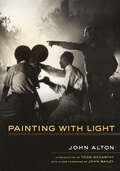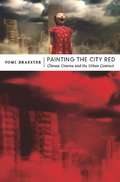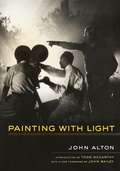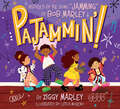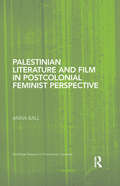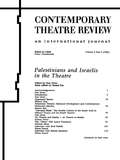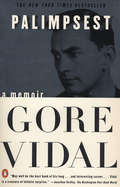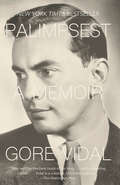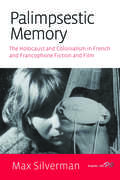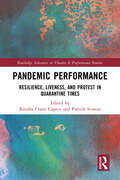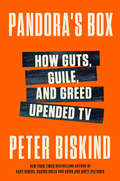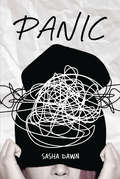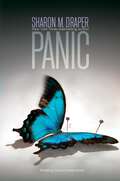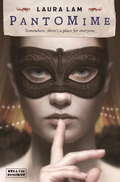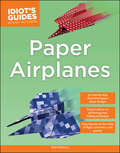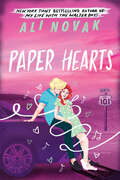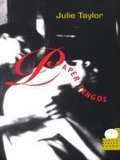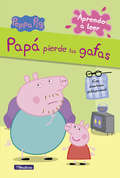- Table View
- List View
Painting With Light
by John AltonFew cinematographers have had as decisive an impact on the cinematic medium as John Alton. Best known for his highly stylized film noir classics T-Men, He Walked by Night, and The Big Combo, Alton earned a reputation during the 1940s and 1950s as one of Hollywood's consummate craftsmen through his visual signature of crisp shadows and sculpted beams of light. No less renowned for his virtuoso color cinematography and deft appropriation of widescreen and Technicolor, he earned an Academy Award in 1951 for his work on the musical An American in Paris. First published in 1949, Painting With Light remains one of the few truly canonical statements on the art of motion picture photography, an unrivaled historical document on the workings of postwar American cinema. In simple, non-technical language, Alton explains the job of the cinematographer and explores how lighting, camera techniques, and choice of locations determine the visual mood of film. Todd McCarthy's introduction provides an overview of Alton's biography and career and explores the influence of his work on contemporary cinematography and the foreword, written expressly for this edition by award-winning cinematographer John Bailey, explores Alton’s often contentious relationships with colleagues, the American Society of Cinematographers, and the movie industry itself.
Painting the City Red: Chinese Cinema and the Urban Contract
by Yomi BraesterPainting the City Red illuminates the dynamic relationship between the visual media, particularly film and theater, and the planning and development of cities in China and Taiwan, from the emergence of the People's Republic in 1949 to the staging of the Beijing Olympics in 2008. Yomi Braester argues that the transformation of Chinese cities in recent decades is a result not only of China's abandonment of Maoist economic planning in favor of capitalist globalization but also of a shift in visual practices. Rather than simply reflect urban culture, movies and stage dramas have facilitated the development of new perceptions of space and time, representing the future city variously as an ideal socialist city, a metropolis integrated into the global economy, and a site for preserving cultural heritage. Drawing on extensive archival research, interviews with leading filmmakers and urban planners, and close readings of scripts and images, Braester describes how films and stage plays have promoted and opposed official urban plans and policies as they have addressed issues such as demolition-and-relocation plans, the preservation of vernacular architecture, and the global real estate market. He shows how the cinematic rewriting of historical narratives has accompanied the spatial reorganization of specific urban sites, including Nanjing Road in Shanghai; veterans' villages in Taipei; and Tiananmen Square, centuries-old courtyards, and postmodern architectural landmarks in Beijing. In Painting the City Red, Braester reveals the role that film and theater have played in mediating state power, cultural norms, and the struggle for civil society in Chinese cities.
Painting with Light
by John AltonThis introduction to the workings of the Hollywood system provides a rich and accessible detail about special effects, technical wizardry and gadgetry, lighting, make-up, the breakdown of crews, and filming strategies.
Pajammin'
by Ziggy MarleyInspired by Bob Marley's iconic song "Jamming," this joyful picture book by eight-time Grammy winner Ziggy Marley about a fun-filled pajama party celebrates screen-free family time, creativity, and connection.Join a family’s pajama party sleepover as they spend a fun night together filled with games, pillow fights, music, and stories. It’s a time to break normal routines, turn off electronics, build a blanket fort, and stay up late—to start family traditions and make memories that will last a lifetime. Using the most iconic lines from reggae legend Bob Marley’s “Jamming” as a jumping-off point, Pajammin’ reinvents the song for kids and caregivers, celebrating mindfulness, togetherness, and the power of imagination.
Palestinian Literature and Film in Postcolonial Feminist Perspective (Routledge Research in Postcolonial Literatures)
by Anna BallPalestinian Literature and Film in Postcolonial Feminist Perspective is the first sustained study of gender-consciousness in the Palestinian creative imagination. Drawing on concepts from postcolonial feminist theory, Ball analyses a range of literary and filmic works by major creative practitioners including Michel Khleifi , Liana Badr, Annemarie Jacir, Elia Suleiman, Mona Hatoum and Suheir Hammad, and reveals a hitherto unrecognized trajectory in gender-consciousness under development in the Palestinian imagination from the start of the twentieth century. The book explores how these works resonate with questions of power, identity, nation, resistance, and self-representation in the Palestinian imagination more broadly, and asks how these gender-conscious narratives transform our understanding of Palestine's struggle for postcoloniality. Working at the cusp of postcolonial, feminist and cultural enquiry, Ball seeks to open up vital new directions in the interdisciplinary study of Palestine.
Palestinians and Israelis in the Theatre
by Dan UrianThe Jewish-Israeli theatre is a complex and developed system in which the dispute with the Palestinians constitutes just one of the important components in its repertoire; while the Palestinian theatre, both within and outside of Israel, is being consolidated. This work brings together these two approaches by relating to the Palestinian theme as it appears in the Jewish-Israeli theatre and by attempting to characterize the Palestinian theatre in general.
Palimpsest: A Memoir (Primera Persona Ser.)
by Gore VidalThis explosively entertaining memoir abounds in gossip, satire, historical apercus, and trenchant observations. Vidal's compelling narrative weaves back and forth in time, providing a whole view of the author's celebrated life, from his birth in 1925 to today, and features a cast of memorable characters—including the Kennedy family, Marlon Brando, Anais Nin, and Eleanor Roosevelt.
Palimpsest: A Memoir (Vintage International)
by Gore VidalVidal on Vidal—a great and supremely entertaining writer on a great and endlessly fascinating subject.A New York Times best American memoir&“In the hands of Gore Vidal, a pen is a sword. And he points it at the high and mighty who have crossed his path.&” —Los Angeles Times Palimpsest is Gore Vidal's account of the first thirty-nine years of his life as a novelist, dramatist, critic, political activist and candidate, screenwriter, television commentator, controversialist, and a man who knew pretty much everybody worth knowing (from Amelia Earhart to Eleanor Roosevelt, the Duke and the Duchess of Windsor, Jack Kennedy, Jaqueline Kennedy, Jack Kerouac, Truman Capote, Andre Gide, and Tennessee Williams, and on and on). Here, recalled with the charm and razor wit of one of the great raconteurs of our time, are his birth into a DC political clan; his school days; his service in World War II; his emergence as a literary wunderkind in New York; his time in Hollywood, London, Paris and Rome; his campaign for Congress (outpolling JFK in his district); and his legendary feuds with, among many others, Truman Capote and William F. Buckley. At the emotional heart of this book is his evocation of his first and greatest love, boyhood friend Jimmy Trimble, killed in battle on Iwo Jima.
Palimpsestic Memory
by Max SilvermanThe interconnections between histories and memories of the Holocaust, colonialism and extreme violence in post-war French and Francophone fiction and film provide the central focus of this book. It proposes a new model of 'palimpsestic memory', which the author defines as the condensation of different spatio-temporal traces, to describe these interconnections and defines the poetics and the politics of this composite form. In doing so it is argued that a poetics dependent on tropes and techniques, such as metaphor, allegory and montage, establishes connections across space and time which oblige us to perceive cultural memory not in terms of its singular attachment to a particular event or bound to specific ethno-cultural or national communities but as a dynamic process of transfer between different moments of racialized violence and between different cultural communities. The structure of the book allows for both the theoretical elaboration of this paradigm for cultural memory and individual case-studies of novels and films.
Pandemic Performance: Resilience, Liveness, and Protest in Quarantine Times (Routledge Advances in Theatre & Performance Studies)
by Kendra Claire CapecePandemic Performance chronicles the many ways that people are surviving/thriving through performance in a global pandemic. Covering artists and events from across the United States: from New York to California and from South Dakota to Texas, the chapters are equal parts theory and practice, weaving scholarship with personal experience from contributors who are interdisciplinary artists, scholars, journalists, and community organizers providing unique and invaluable perspectives on the complicated work of resilience during COVID-19. This study will hold interest for students and scholars in the performing arts, arts, and social justice as well as professional artmakers and creative community organizers.
Pandemie im Film: Religiöse und ästhetische Transformationen in der Populärkultur (pop.religion: lebensstil – kultur – theologie)
by Harald Schroeter-Wittke Inge KirsnerUntersucht wird die theologische und ästhetische Bearbeitung der Pandemien in dystopischen und Science-Fiction-Filmen sowie Serien. Zwischen Verschwörungstheorien, der Sicht als Strafe Gottes und der fatalistischen Annahme eines "notwenigen Übels" changieren die Erklärungsmodelle im Film wie auch in der gesellschaftlichen Wirklichkeit. Filme bieten dabei stellvertretend narrative Lösungsmodelle an. Die Katastrophe wird auf diese Weise dem beängstigenden Alltag für kurze Zeit enthoben, was eine der Reflexion zuträgliche Distanz ermöglicht. Exemplarisch wird ein sich wandelndes Rollen-, Gesellschafts- und Gottesbild aufgezeigt, das zu religionspädagogischen Reflexionen anregt.
Pandora's Box: How Guts, Guile, and Greed Upended TV
by Peter BiskindA NEW YORKER BEST BOOKS OF 2023 SELECTION“Biskind’s saga about the rise and fall of prestige television explains, in punchy, propulsive prose, how we went from Tony Soprano to Ted Lasso.” —New YorkerBestselling author of Easy Riders, Raging Bulls and Down and Dirty Pictures, cultural critic Peter Biskind turns his eye toward the new golden age of television, sparked by the fall of play-it-safe network TV and the rise of boundary-busting cable, followed by streaming, which overturned both—based on exclusive, candid, and colorful interviews with executives, writers, showrunners, directors, and actorsWe are now lucky enough to be living through the era of so-called Peak TV, in which television, in its various guises and formats, has seized the entertainment mantle from movies and dominates our leisure time. How and why this happened is the subject of this book.Instead of focusing on one service, like HBO, Pandora’s Box asks, “What did HBO do, besides give us The Sopranos?” The answer: It gave us a revolution. Biskind bites off a big chunk of entertainment history, following HBO from its birth into maturity, moving on to the basic cablers like FX and AMC, and ending up with the streamers and their wars, pitting Netflix against Amazon Prime Video, Max, and the killer pluses—Disney, Apple TV, and Paramount.Since the creative and business sides of TV are thoroughly entwined, Biskind examines both, and the interplay between them. Through frank and shockingly intimate interviews with creators and executives, Pandora’s Box investigates the dynamic interplay of commerce and art through the lens the game-changing shows they aired—not only old warhorses like The Sopranos, but recent shows like The White Lotus, Succession, and Yellow- (both -stone and -jackets)—as windows into the byzantine practices of the players as they use money and guile to destroy their competitors.In the end, this book crystal-balls the future in light of the success and failures of the streamers that, after apparently clearing the board, now face life-threatening problems, some self-created, some not. With its long view and short takes—riveting snapshots of behind-the-scenes mischief—Pandora’s Box is the only book you’ll need to read to understand what’s on your small screen and how it got there.
Panic
by Sasha DawnA page-turning story about a teen's struggle to overcome her fears on her quest for truth, strength, and stardom. Madelaine loves music, loves the stage, and loves performing. When she finds a fragment of poetry that inspires her to finish a song she's been writing, she tracks down the poem's author online in hopes of starting a collaboration. But as more pieces of the poem find their way to her, she realizes the online poet can't possibly be the one who's leaving them for her. At the same time, some shocking family secrets upend Madelaine's home life. As Madelaine struggles to separate the images people present online from the realities of who they are, her quest for truth, strength, and stardom takes turns she never expected.
Panic
by Sharon M. DraperThis gripping, chillingly realistic novel from New York Times bestselling author Sharon Draper, “by turns pulse-pounding and inspiring” (Kirkus Reviews), shows that all it takes is one bad decision for a dream to become a nightmare.Diamond knows not to get into a car with a stranger. But what if the stranger is well-dressed and handsome? On his way to meet his wife and daughter? And casting a movie that very night—a movie in need of a star dancer? What then? Then Diamond might make the wrong decision. It’s a nightmare come true: Diamond Landers has been kidnapped. She was at the mall with a friend, alone for only a few brief minutes—and now she’s being held captive, forced to endure horrors beyond what she ever could have dreamed, while her family and friends experience their own torments and wait desperately for any bit of news. From New York Times bestselling author Sharon Draper, this is a riveting exploration of power: how quickly we can lose it—and how we can take it back.
Panoramas and Compilations in Nineteenth-Century Britain: Seeing the Big Picture (Palgrave Studies in Nineteenth-Century Writing and Culture)
by Helen KingstoneThis book shows how in nineteenth-century Britain, confronted with the newly industrialized and urbanized modern world, writers, artists, journalists and impresarios tried to gain an overview of contemporary history. They drew on two successive but competing conceptual models of overview: the panorama and the compilation. Both models claimed to offer a holistic picture of the present moment, but took very different approaches. This book shows that panoramas (360° views previously associated with the Romantic period) and compilations (big data projects previously associated with the Victorian fin de siècle) are intertwined, relevant across the entire century, and often remediated, making them crucial lenses through which to view a broad range of genre and forms. It brings together interdisciplinary research materials belonging to different period silos to create new understandings of how nineteenth-century audiences dealt with information overload. It argues for a new politics of distance: one that recognizes the value of immersing oneself in a situation, event or phenomenon, but which also does not chastise us for trying to see the big picture. This book is essential reading for students and scholars of nineteenth-century literature, history, visual culture and information studies.
Pantallas de plata
by Carlos FuentesThis is the story of a personal relationship with cinema. Carlos Fuentes tells about his earliest encounter with a movie theater while accompanied by his father, the dazzling moving images on the silver screen, and his subsequent and incurable love for cinema. The author had the opportunity to see movies in a good number of countries on both sides of the Atlantic, to know great directors and famous actors and actresses, to write screenplays, to see his own works translated to film, to be a judge in renowned festivals, and even to act. From all of this he derives a unique experience that he narrates here in absolutely confessional terms, and a good part of the time in first person. His preferences and likes, his obsessions, his interpretation of works, attitudes, tendencies, styles; all this and more is found here, written in a style more narrative than essay in tone. This work, just as it was written by the author, is a gift for readers, especially those who enjoy the greatest films of all time.
Pantomime
by Laura LamR.H. Ragona's Circus of Magic is the greatest circus of Ellada. Nestled among the glowing blue Penglass - remnants of a mysterious civilisation long gone - are wonders beyond the wildest imagination. It's a place where anything seems possible, where if you close your eyes you can believe that the magic and knowledge of the vanished Chimeras is still there. It's a place where anyone can hide.Iphigenia Laurus, or Gene, the daughter of a noble family, is uncomfortable in corsets and crinoline, and prefers climbing trees to debutante balls. Micah Grey, a runaway living on the streets, joins the circus as an aerialist's apprentice and soon becomes the circus's rising star. But Gene and Micah have balancing acts of their own to perform, and a secret in their blood that could unlock the mysteries of Ellada.
Papa John: The Autobiography Of John Phillips
by John Phillips Jim JeromeSex, drugs, and rock 'n ' roll. It was the anthem of the sixties. The psychedelic code by which many lived --and died. And John Phillips, legendary founder and songwriter of the Mamas and the Papas, experienced it all. Now Phillips takes us on a dizzying roller-coaster ride from stardom in L.A. to drug busts in the Big Apple. In an intimate, gritty, all- too-true self-portrait, he offers a startling, reflective look at the turbulent sixties and beyond.
Paper Airplanes (Idiot's Guides)
by Nick RobinsonRelated to origami, paper airplanes originated from China and are toys devised entirely out of paper and adhesives (sometimes glue or tape) that utilize an aerodynamic shape to lift and soar. Idiot's Guides: Paper Airplanes features 20 of the coolest designs-- and offers easy-to-understand, step-by-step instructions. This book includes:- Step-by-step easy-to-understand illustrated folding instructions, including the level of cutting/folding difficulty, flight pattern, and durability levels to the corresponding airplanes. - 20 symmetric models, ranging in difficulty levels, which are illustrated within the colorful guide.- 80 sheets of eye-catching, pre-designed printed 8.5x11 paper for readers to practice with and create planes.- Cool backgrounds that highlight each of the airplane projects.
Paper Hearts (The Heartbreak Chronicles #2)
by Ali NovakFrom beloved Wattpad sensation Ali Novak, author of My Life with the Walter Boys, comes this never-before-published companion to The Heartbreakers, perfect for fans of Jenny Han and Kasie West"I'm sorry," he said, slowly untying the ribbon that held his mask in place. "It's just—I didn't want you to think of me any differently." Somehow I kept my mouth from falling open. I knew his face, but my mind couldn't accept that he was the person looking down at me. "My real name is Alec."Felicity has her entire future planned. Ever since her older sister ran away, she's had the full weight of her mother's expectations on her shoulders. So she works hard to get straight As and save for college.Except sometimes the best things in life are unplanned—like when Felicity meets a handsome, masked stranger while she is volunteering at a charity masquerade ball. She never thought he'd flirt with her. And she certainly never thought he'd turn out to be a member of the world-famous Heartbreakers band, Alec.Then Felicity uncovers a shocking family secret. Suddenly, she, Alec, and her two best friends are off on a road trip to find Felicity's missing sister. And she's about to discover that unexpected turns have a peculiar way of landing her right where she needs to be…With a perfect balance of humor, heart, and romance, Paper Hearts is a great choice for readers looking for:fun contemporary romance for teensswoon-worthy Wattpad love storiesromcoms that cover deeper issues like family and self-discoverybinge-worthy YA novels
Paper Tangos
by Julie TaylorTango. A multidimensional expression of Argentine identity, one that speaks to that nation's sense of disorientation, loss, and terror. Yet the tango mesmerizes dancers and audiences alike throughout the world. In Paper Tangos, Julie Taylor--a classically trained dancer and anthropologist--examines the poetics of the tango while describing her own quest to dance this most dramatic of paired dances.Taylor, born in the United States, has lived much of her adult life in Latin America. She has spent years studying the tango in Buenos Aires, dancing during and after the terror of military dictatorships. This book is at once an account of a life lived crossing the borders of two distinct and complex cultures and an exploration of the conflicting meanings of tango for women who love the poetry of its movement yet feel uneasy with the roles it bestows on the male and female dancers. Drawing parallels among the violences of the Argentine Junta, the play with power inherent in tango dancing, and her own experiences with violence both inside and outside the intriguing tango culture, Taylor weaves the line between engaging memoir and insightful cultural critique. Within the contexts of tango's creative birth and contemporary presentations, this book welcomes us directly into the tango subculture and reveals the ways that personal, political, and historical violence operate in our lives.The book's experimental design includes photographs on every page, which form a flip-book sequence of a tango. Not simply a book for tango dancers and fans, Paper Tangos will reward students of Latin American studies, cultural studies, anthropology, feminist studies, dance studies, and the art of critical memoir.
Papá pierde las gafas (Peppa Pig. Pictogramas)
by Varios AutoresEn esta divertida historia te contamos lo que pasó cuando Papá Pig perdió sus gafas. ¡Descubre cómo logramos encontrarlas! Papá Pig está leyendo el periódico y no encuentra sus gafas. Peppa y George se ofrecen para ayudarle a buscarlas. Descubre dónde encuentra Peppa las gafas. ¡Para que los más peques se diviertan leyendo esta historia con pictogramas y aprendiendo el vocabulario!
Parade
by Donald CrewsShowing the same dynamic energy and brilliant colors as in <i>Freight Train</i> and <i>Truck</i>, Donald Crews conveys the breathless anticipation and delighted enjoyment generated by a parade in this book.
Paradoxical Right-Wing Sexual Politics in Europe (Global Queer Politics)
by Cornelia Möser Jennifer Ramme Judit TakácsHow did far-right, hateful and anti-democratic ideologies become so successful in many societies in Europe? This volume analyses the paradoxical roles sexual politics have played in this process and reveals that the incoherence and untruthfulness in right-wing populist, ultraconservative and far-right rhetorics of fear are not necessarily signs of weakness. Instead, the authors show how the far right can profit from its own incoherence by generating fear and creating discourses of crisis for which they are ready to offer simple solutions. In studies on Poland, Hungary, Spain, Italy, Austria, Ireland, Northern Ireland, Portugal, France, Sweden and Russia, the ways far-right ideologies travel and take root are analysed from a multi-disciplinary perspective, including feminist and LGBTQI reactions. Understanding how hateful and antidemocratic ideologies enter the very centre of European societies is a necessary premise for developing successful counterstrategies.
Parallel Lines
by Guy WestwellParallel Lines describes how post-9/11 cinema, from Spike Lee's 25th Hour (2002) to Kathryn Bigelow's Zero Dark Thirty (2012), relates to different, and competing, versions of US national identity in the aftermath of the September 11th terrorist attacks. The book combines readings of individual films (World Trade Center, United 93, Fahrenheit 9/11, Loose Change) and cycles of films (depicting revenge, conspiracy, torture and war) with extended commentary on recurring themes, including the relationship between the US and the rest of the world, narratives of therapeutic recovery, questions of ethical obligation.The volume argues that post-9/11 cinema is varied and dynamic, registering shock and upheaval in the immediate aftermath of the attacks, displaying capacity for critique following the Abu Ghraib prisoner abuse scandal mid-decade, and seeking to reestablish consensus during Obama's troubled second term of office.
